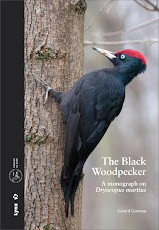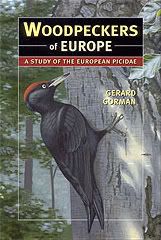 This shot of a female Black Woodpecker foraging recently in Hungary is by Dan Bastaja. Note the red is only on the hind crown (rather than on the whole crown as on males). In most winters, woodpeckers rove a little more than at other times of year and are often more approachable as they forage in difficult conditions. Black Woodpeckers will come down to the ground to feed and are often first located by the sound of the solid, single "knocks" they make on timber. If carefully approached they will remain and feed where they are. This foraging site is clearly a fairly new one, judging by the freshness of the hacked away timber. Snow rarely presents a problem to Black Woodpeckers as long as it is not several feet deep. They will swish snow away with sideways blows of their large bill to get at hibernating invertebrates, such as ants, in timber beneath.
This shot of a female Black Woodpecker foraging recently in Hungary is by Dan Bastaja. Note the red is only on the hind crown (rather than on the whole crown as on males). In most winters, woodpeckers rove a little more than at other times of year and are often more approachable as they forage in difficult conditions. Black Woodpeckers will come down to the ground to feed and are often first located by the sound of the solid, single "knocks" they make on timber. If carefully approached they will remain and feed where they are. This foraging site is clearly a fairly new one, judging by the freshness of the hacked away timber. Snow rarely presents a problem to Black Woodpeckers as long as it is not several feet deep. They will swish snow away with sideways blows of their large bill to get at hibernating invertebrates, such as ants, in timber beneath.Thursday 20 December 2007
Black Woodpecker foraging in winter
 This shot of a female Black Woodpecker foraging recently in Hungary is by Dan Bastaja. Note the red is only on the hind crown (rather than on the whole crown as on males). In most winters, woodpeckers rove a little more than at other times of year and are often more approachable as they forage in difficult conditions. Black Woodpeckers will come down to the ground to feed and are often first located by the sound of the solid, single "knocks" they make on timber. If carefully approached they will remain and feed where they are. This foraging site is clearly a fairly new one, judging by the freshness of the hacked away timber. Snow rarely presents a problem to Black Woodpeckers as long as it is not several feet deep. They will swish snow away with sideways blows of their large bill to get at hibernating invertebrates, such as ants, in timber beneath.
This shot of a female Black Woodpecker foraging recently in Hungary is by Dan Bastaja. Note the red is only on the hind crown (rather than on the whole crown as on males). In most winters, woodpeckers rove a little more than at other times of year and are often more approachable as they forage in difficult conditions. Black Woodpeckers will come down to the ground to feed and are often first located by the sound of the solid, single "knocks" they make on timber. If carefully approached they will remain and feed where they are. This foraging site is clearly a fairly new one, judging by the freshness of the hacked away timber. Snow rarely presents a problem to Black Woodpeckers as long as it is not several feet deep. They will swish snow away with sideways blows of their large bill to get at hibernating invertebrates, such as ants, in timber beneath.Saturday 15 December 2007
Grey-headed (Grey-faced) Woodpecker: foraging on rock walls
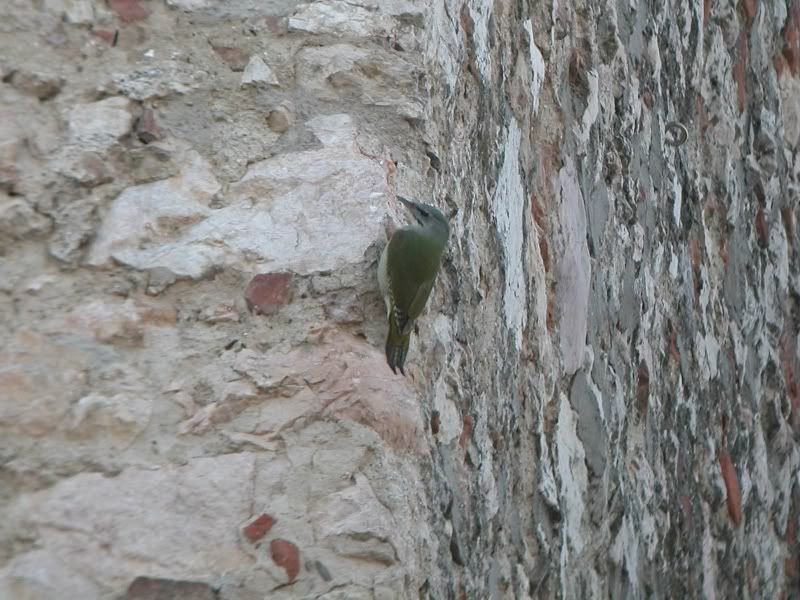 Grey-headed Woodpecker Picus canus will cling to rock faces, quarry walls, and even buildings. This species does this more than any other European picid. In fact, I would say that this foraging technique is common. The birds are foraging for insects, spiders and other invertebrates, examining cracks and crevices. These two photos show different females in stone quarries in Hungary, First taken by Gabor Vasuta, second by Szabolcs Kokay. In both photos note how the central tail feathers are used to good effect as props, as is done when on trees.
Grey-headed Woodpecker Picus canus will cling to rock faces, quarry walls, and even buildings. This species does this more than any other European picid. In fact, I would say that this foraging technique is common. The birds are foraging for insects, spiders and other invertebrates, examining cracks and crevices. These two photos show different females in stone quarries in Hungary, First taken by Gabor Vasuta, second by Szabolcs Kokay. In both photos note how the central tail feathers are used to good effect as props, as is done when on trees.
Tuesday 11 December 2007
Anatomy, structure: feet
 Like most tree-dwelling birds, woodpeckers have zygodactyl feet. That is, they have four toes arranged in the so-called "yoke" formation of two toes (digits 2 and 3) pointing fowards and two pointing backwards (digits 1 and 4). However, this yoke formation (a kind of "X" shape) changes when woodpeckers climb as their feet are rotated with digit 4 usually held in a lateral position. In Europe Three-toed Woodpecker is the exception (hence the name) as it has completely lost digit 1. In fact, all woodpeckers are "three-toed" in terms of using their toes, as digit 1 is very short and almost redundant. All woodpeckers have relatively short legs and feet and their toes are tipped by strong claws. These adaptations are related to their arboreal lifestyle. The sharp claws are ideal for gripping tree surfaces, even very smooth bark, as in this photo of a Middle Spotted Woodpecker (taken in Hungary by Dan Bastaja).
Like most tree-dwelling birds, woodpeckers have zygodactyl feet. That is, they have four toes arranged in the so-called "yoke" formation of two toes (digits 2 and 3) pointing fowards and two pointing backwards (digits 1 and 4). However, this yoke formation (a kind of "X" shape) changes when woodpeckers climb as their feet are rotated with digit 4 usually held in a lateral position. In Europe Three-toed Woodpecker is the exception (hence the name) as it has completely lost digit 1. In fact, all woodpeckers are "three-toed" in terms of using their toes, as digit 1 is very short and almost redundant. All woodpeckers have relatively short legs and feet and their toes are tipped by strong claws. These adaptations are related to their arboreal lifestyle. The sharp claws are ideal for gripping tree surfaces, even very smooth bark, as in this photo of a Middle Spotted Woodpecker (taken in Hungary by Dan Bastaja).
Saturday 8 December 2007
Anatomy, structure: tail

Most woodpeckers have rigid, strong central tail feathers which they use as props and supports when on tree trunks and branches. A sold, firm posture is important when a woodpecker is hacking at timber and the strong tail helps provide this. Note how the tail feathers on this male Black Woodpecker (photo by Gabor Vasuta, Hungary) are splayed and pressed against the branch, acting as stabalisers. The bird is not really perched, but rather presssed against the branch.
Friday 7 December 2007
Anatomy, structure
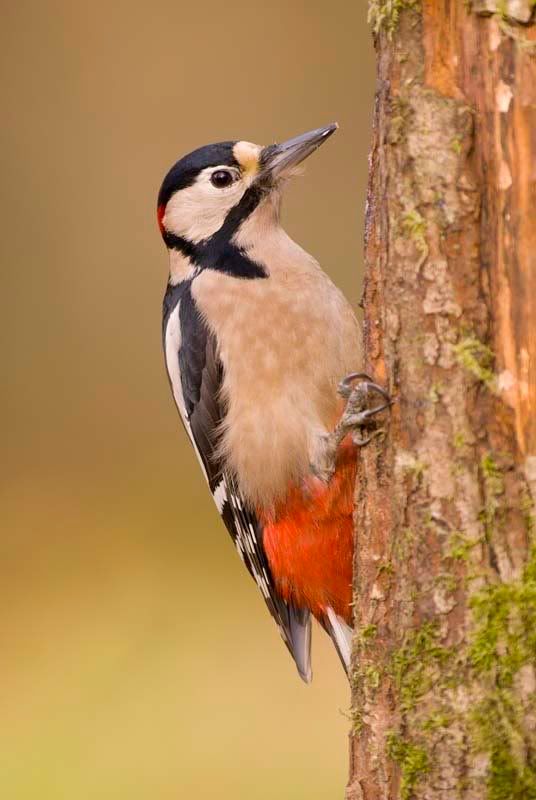 Woodpeckers are robustly built birds. They have a unique anatomy that enables them to exploit habitat and food niches that are unavailable to most other birds, and indeed many mammals. They have evolved many anatomical and structural features that allow them to cling to and climb up and down wood surfaces (which are often smooth) and hack into timber. These features include muscular bodies, tough skin, enlarged and adapted skulls, relatively large ribs, broad tendons, ridged chisel-shaped bills, strong feet, sharp claws, particularly strong tail feathers, and many others.
Woodpeckers are robustly built birds. They have a unique anatomy that enables them to exploit habitat and food niches that are unavailable to most other birds, and indeed many mammals. They have evolved many anatomical and structural features that allow them to cling to and climb up and down wood surfaces (which are often smooth) and hack into timber. These features include muscular bodies, tough skin, enlarged and adapted skulls, relatively large ribs, broad tendons, ridged chisel-shaped bills, strong feet, sharp claws, particularly strong tail feathers, and many others.Many of these features can be seen well on this photo of Great Spotted Woodpecker here, taken in Sussex, England by David Plummer: http://www.davidplummerimages.co.uk/
Note the broad chisel-shaped bill with a sharp tip, The robust legs and feet with long sharp claws and the overall stout, strong body.
Thursday 6 December 2007
Signs: acorns
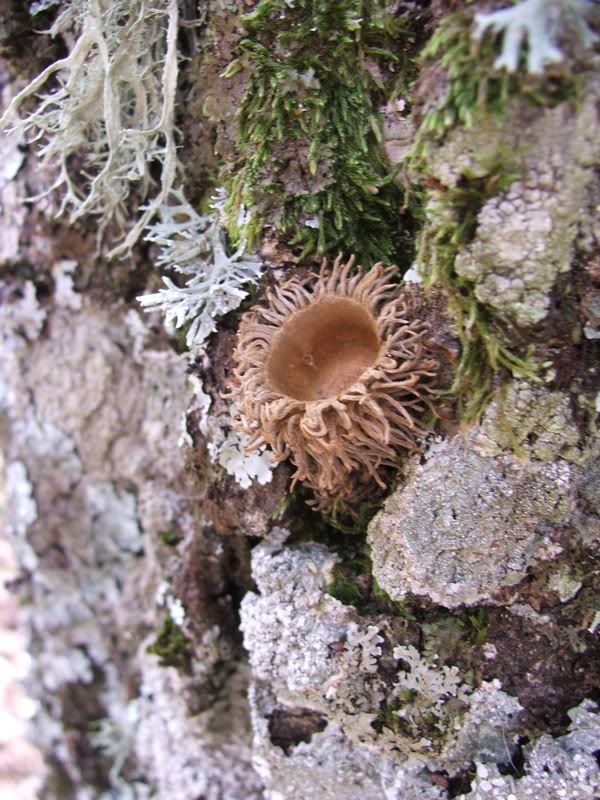 These photos of acorns wedged into crevices in tree trunks were taken by Adriano Castelmezzano in the Pollino area in Basilicata, southern Italy. These "anvils" or "workshops" were situated very low down on the trees, just above the ground. Food items such as these (and pine cones) are wedged into position and hacked open in situ. It is not always possible to say with certainty that such work has not been done by a Nuthatch Sitta europaea but it is more likely the work of a Great Spotted Woodpecker. Beak marks, which are not clear here, are often the best clue. The only other European woodpecker that regularly works with food items in this way is Syrian Woodpecker, and this species is not present in Italy.
These photos of acorns wedged into crevices in tree trunks were taken by Adriano Castelmezzano in the Pollino area in Basilicata, southern Italy. These "anvils" or "workshops" were situated very low down on the trees, just above the ground. Food items such as these (and pine cones) are wedged into position and hacked open in situ. It is not always possible to say with certainty that such work has not been done by a Nuthatch Sitta europaea but it is more likely the work of a Great Spotted Woodpecker. Beak marks, which are not clear here, are often the best clue. The only other European woodpecker that regularly works with food items in this way is Syrian Woodpecker, and this species is not present in Italy.
Wednesday 5 December 2007
Syrian and Great Spotted Woodpeckers excavating together
 Not only did the female Syrian Woodpecker in the previous post (below) show unusual plumage, but she was also associated with a male Great Spotted Woodpecker, forming a pair. Together, the female Syrian and male Great Spotted excavated a nest-hole, in a false acacia (robinia) tree at Apaj, SE of Budapest, Hungary. Unfortunately, it is not known whether this pair subsequently mated and produced any young. Here are more photos, by Bence Kokay: 1st: female Syrian Woodpecker. 2nd: male Great Spotted Woodpecker.
Not only did the female Syrian Woodpecker in the previous post (below) show unusual plumage, but she was also associated with a male Great Spotted Woodpecker, forming a pair. Together, the female Syrian and male Great Spotted excavated a nest-hole, in a false acacia (robinia) tree at Apaj, SE of Budapest, Hungary. Unfortunately, it is not known whether this pair subsequently mated and produced any young. Here are more photos, by Bence Kokay: 1st: female Syrian Woodpecker. 2nd: male Great Spotted Woodpecker.
Tuesday 4 December 2007
Syrian Woodpecker: unusual plumage
 The more I study woodpeckers, the more unusual things I find. European woodpeckers, especially the Dendrocopos species, the so-called "pied woodpeckers" often show unusual, atypical plumage features. Sometimes, the are so striking that it is hard to decide whether a bird is a hybrid of some kind or simply atypical. Most of the unusual plumages I have seen concern Great Spotted Woodpecker and Syrian Woodpecker. The photo here shows an adult female Syrian Woodpecker, taken at a nest-hole at Apaj, Hungary, by Bence Kokay, in spring 2007 (more on this nest in subsequent post). Note that the bird has a small red spot on the hindcrown, low down on the left side. Of course, female Syrians should not show any red on the crown, though juvenile females do. Are these red feather tips remnants of the bird's juvenile plumage ? Or is there another explanation ?
The more I study woodpeckers, the more unusual things I find. European woodpeckers, especially the Dendrocopos species, the so-called "pied woodpeckers" often show unusual, atypical plumage features. Sometimes, the are so striking that it is hard to decide whether a bird is a hybrid of some kind or simply atypical. Most of the unusual plumages I have seen concern Great Spotted Woodpecker and Syrian Woodpecker. The photo here shows an adult female Syrian Woodpecker, taken at a nest-hole at Apaj, Hungary, by Bence Kokay, in spring 2007 (more on this nest in subsequent post). Note that the bird has a small red spot on the hindcrown, low down on the left side. Of course, female Syrians should not show any red on the crown, though juvenile females do. Are these red feather tips remnants of the bird's juvenile plumage ? Or is there another explanation ?
Monday 3 December 2007
Quiz woodpecker 8
Middle Spotted Woodpecker, Abruzzo NP, Italy
 This photo, taken by my fellow woodpecker enthusiast Paul Harris in mid-June 2007, is very important. It shows a Middle Spotted Woodpecker Dendrocopos medius with food in its bill at a nest hole in the Abruzzo National Park, central Italy. This species is very rare indeed in that area: this is only the 3rd nest ever found in the Abruzzo, the other two being found in the early 1980s.
This photo, taken by my fellow woodpecker enthusiast Paul Harris in mid-June 2007, is very important. It shows a Middle Spotted Woodpecker Dendrocopos medius with food in its bill at a nest hole in the Abruzzo National Park, central Italy. This species is very rare indeed in that area: this is only the 3rd nest ever found in the Abruzzo, the other two being found in the early 1980s.
Subscribe to:
Posts (Atom)



